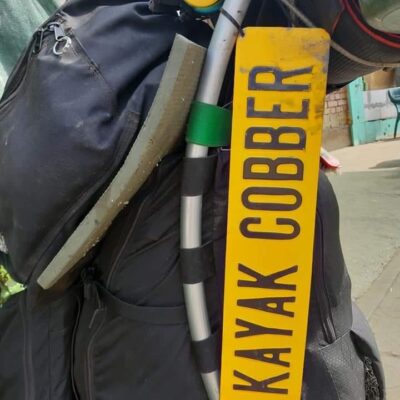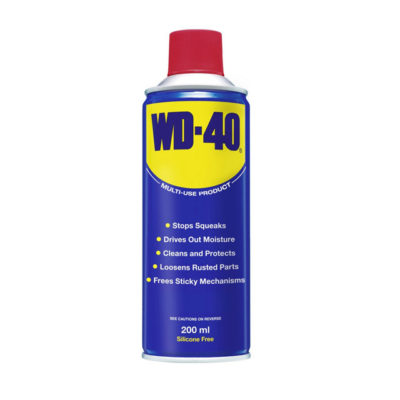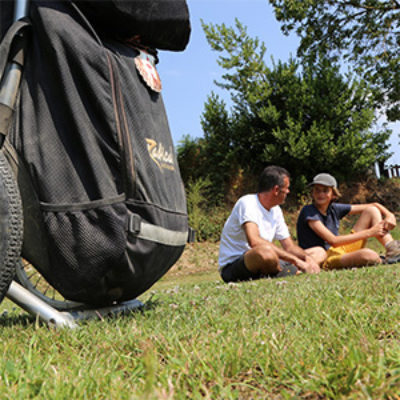8 Camino Routes with a Walking Trailer
Since 2015 Paul Flipsen has walked 8 different Camino routes with the Wheelie Walking Trailer. There is no way he would ever consider changing back to using a backpack. But he is also realistic about the possibilities and impossibilities of the Wheelie. Paul wrote down his experiences with the Walking Trailer on the various Camino routes to help other Wheelie owners make their choice for alternative Caminos. We hope that it may also be of use for people who consider buying one.
Preperation
- Choice between backpack and walking trailer
- First test of the Wheelie
- Packing the Wheelie for the Camino
- The Wheelie uphill
- The walking cart in the hostel or stay
The Camino Routes
- Camino from home via Voie de Vezelay and Camino del Norte to Santiago
- Camino Fisterra, Muxia and from A Coruna the Camino Inglés
- Camino del Salvador (León-Oviedo)
- Camino Primitivo (Oviedo-Santiago)
- Camino Inglés (Ferrol-Santiago)
- Camino Lebaniego/Ruta Vadiniense (Santander-Mansilla de las Mulas)
- Camino Francés
- Camino Invierno (Ponferrada to Santiago de Compostela)
- Final word
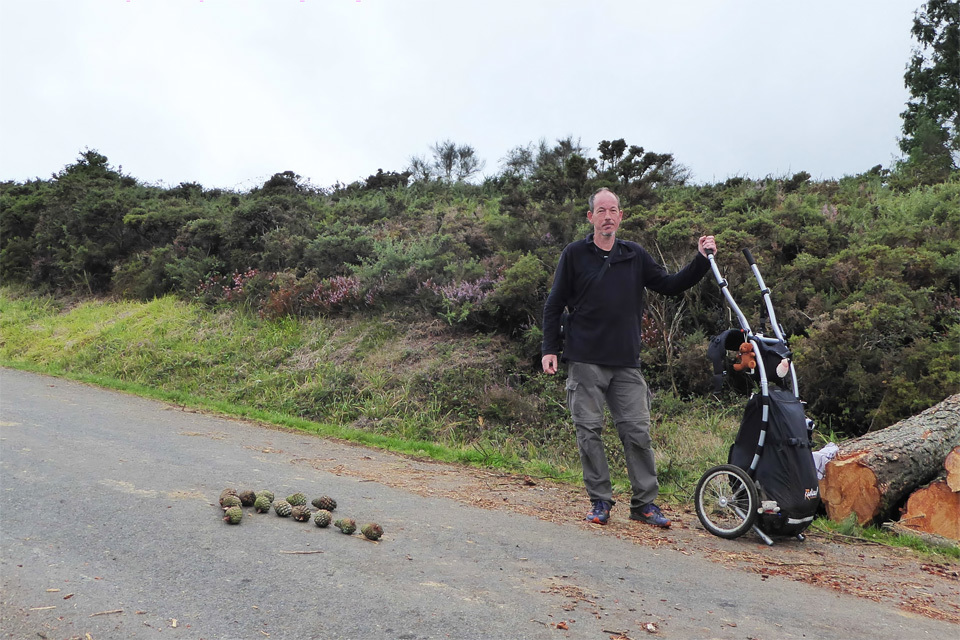
Paul has walked 8 different Camino routes with a walking trailer
Choice between backpack and walking trailer
For my first pilgrim route to Santiago, from home (South Limburg), I had to make the difficult choice between a backpack or a Wheelie.
For me the total weight of the luggage was decisive. For a backpack, a limitation of 10 to max. 12 kg applies. However, because I wanted a bit of freedom on the road and wanted to take my tent with me, I ended up with more than 15 kg (without water and food).
I then purchased a Wheelie Walking Trailer (after reading the experiences of various users on the internet). The underlying idea was to give the Wheelie a try in familiar terrain (Belgian Ardennes) and possibly sell it 2nd hand when the experience would turn out disappointing (there is a lot of demand for it!).
The Ardennes are underestimated in terms of difficulty, for walking, but certainly with a Wheelie. By experience I know that the Ardennes is certainly not inferior to most pilgrim routes.
First test of the Wheelie
For more than a 100km. I've tested the Wheelie. Thanks to the large wheels, stairs, but also tree roots and boulders are not such a huge problem. Waters up to a cm. or 20 high can also be traversed. Mud is also good to do (but I'll come back to that later!).
After this test I was very enthusiastic about my purchase. On flat and slightly rising / descending roads (asphalt, country roads, grass paths, gravel paths), the Wheelie is simply a lot more comfortable than a backpack. Well loaded the Wheelie holds the heavier luggage above the wheel axle allowing to walk almost without weight. Advantages compared to the backpack are a free (not sweaty) back, almost no load on the back / knees and with a backpack you are top heavy / out of balance (try tying your shoelaces!).
Packing the hiking cart for the Camino
I purchased a set of nylon laundry bags from IKEA. This way you can sort your luggage in a well-organized way. I also purchased the Gearbag, so you can always quickly remove valuable items (phone, camera, money, etc.) from the Wheelie and carry it with you. Moreover, it is very handy that a water bottle fits in the Gearbag. Another useful option is the Expedition Crossbar (now standard in the Wheelie V), which makes the frame of the Wheelie considerably stronger.
The rain cover for the Wheelie (standard with the Wheelie Traveller) requires some practice to apply it properly. Nowadays, however, I usually leave it on (because of the yellow color well visible on the road and in case of sudden rain you don't have to struggle with the cover for minutes).
With a Wheelie you can easily take too much baggage (plenty of space). However, I have reduced the weight every year (also by purchasing lightweight material) and I walked the last pilgrim route with around 12 kg of luggage (Wheelie itself is another 6 kg).
The Wheelie in the hills
Steeper uphill with the Wheelie can be pretty tough. Fortunately, these are often relatively short moments and you can catch your breath on a flatter part. If the path is wide enough, zigzagging walking up is also a good option.
Steep downhill is actually tougher. It gives a considerable weight on the knees. Here too, zigzag walking is often a good solution. If it gets very steep, take the Wheelie in front of you and let it pull you, which also eases the strain on the knees. A good option here could be a braked Wheelie. I opted for no brakes to save weight.
The walking cart in the hostel or stay
To return to the mud... The Wheelie just goes through mud nicely. However, there is an additional problem, some hostels along the way do not let you in. Hence it is advisable to bring a little washing brush and clean everything up at a stream or water tap. If possible, driving through the grass at the sides of the road will also help.
I have had few problems finding shelter in hostels. However, the Wheelie is often not allowed in the dormitory and must remain outside under a shelter. With the aforementioned IKEA laundry bags and removable Gearbag however, this is not a problem and you will have to take your necessary and valuable items to the dormitory / shower room.
Personally, I have never had to deal with theft / vandalism on the pilgrim roads and have rarely heard of it.
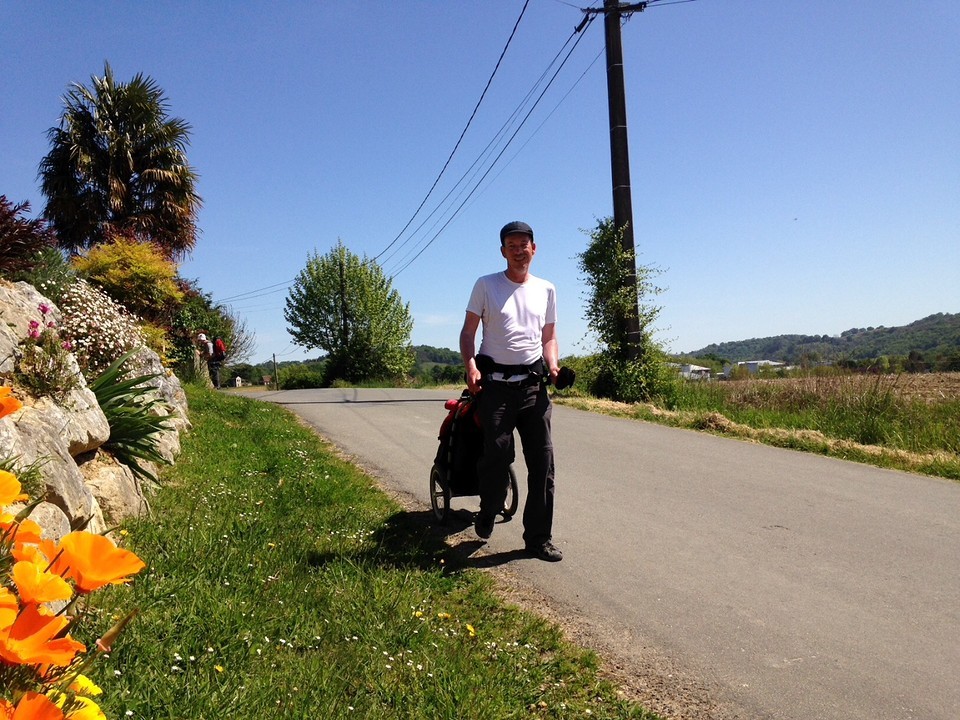
With the Wheelie through the beautiful surroundings of Orthez
De Camino Routes
Below the various routes to Santiago (which I have walked myself) and possible obstacles. I'm quite fanatic with my Wheelie and I think that all Caminos are possible. Of course, the weight of the route depends on your own condition, the weather, the total weight that you drag along and so on. The following is therefore quite colored, but gives an idea of what you can expect from obstacles. A general remark: always immerse yourself in the route for the coming day, there are usually alternative (simpler) routes possible!
1. Camino from home via Voie de Vezelay and Camino del Norte to Santiago
The Netherlands (South Limburg): Very easy to do. The so-called English fence stiles can be a problem in meadows. The Wheelie must then be lifted over the barbed wire. If necessary, unpack some luggage and lift the Wheelie over the wire.
Belgium (via Mosana): Noticeably more difficult. Mud, tree roots, steep climbs and valleys. Narrow paths and possibly a little water. Near Esneux, for example, there is a boulder of 1.5 meters high. Try to get a good stand on that rock and pull the Wheelie up with her wheels along this rock. Possibly unpack some luggage to reduce weight.
France (Voie de Vezelay): Northern and Central France doable. Of course, occasional climbing and descending, but not particularly steep. In the South of France between Orthez and Saint Jean Pied de Port you come across some difficult forest paths. Certainly in the rain a few steep sections can be quite daunting. Inspect the route and take the asphalt road in wet weather.
Saint Jean Pied de Port to Irun: Is marked as a pilgrim road and follows GR10 and GR8. Not recommended to do this with a Wheelie. I did and I think this is one of the toughest routes for a Wheelie. But here too you can choose a simpler route by studying the map.
Spain (Camino del Norte): Difficult start. Immediately a steep climb at Irun and then follow a rocky path towards Dinibane. Not easy, but it is doable. The asphalt road is an alternative... less attractive, but simpler. Donibane descent, ferry crossing and climb Pasai San Pedro. Steep descents (partly stairs) and steep climbing. You get some help from the ferryman when getting on and off the ferry. Donostia / San Sebastian (and returns later in various places): avoid the beach. Loose sand is the worst thing you can come across with the Wheelie. It feels like you are dragging 50 kg of potatoes. Did you end up on the beach? Take the flood line, sice that rides a lot smoother. After Zarautz you come across a rough path with huge boulders. Difficult, but there is an alternative road. Just climb vigorously and descend again for Bilbao, but doable. Pobeña: avoid the stretch of beach at the end, very heavy. For the rest, the del Norte is not too bad and is easy to do. Note: often 2 routes, coast or more inland. The coast is slightly heavier, sometimes pebbles, sand and the like (but nicer!). Positive is that fellow pilgrims / natives are often willing to help you. Often when I climbed a flight of stairs, someone spontaneously lifted my cart from behind to help!
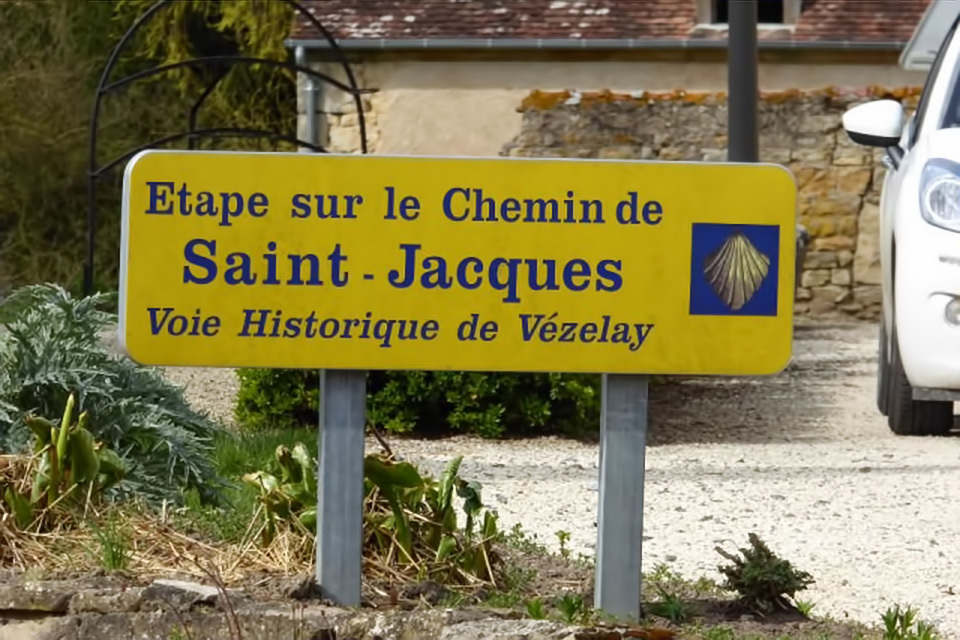
Saint Jacques signage
The most beautiful village in France? Apremont Sur Allier
2. Camino Fisterra, Muxia and from A Coruna the Camino Inglés
Santiago to Fisterra: Long stages (count on 30 km.). In addition to climbing / descending and some boulders on the path quite doable.
Fisterra to Muxia: Also 30km. Same story.
Bus to A Coruna: With disassembled tow bars you can take the Wheelie with you on the bus! This is also the way I travel back and forth between The Nethrlands and Spain. The Wheelie can easily come with Interliner or Flixbus. Disassemble the tow bars and no problem.
Camino Inglés from A Coruna to Santiago: No major problems, doable.
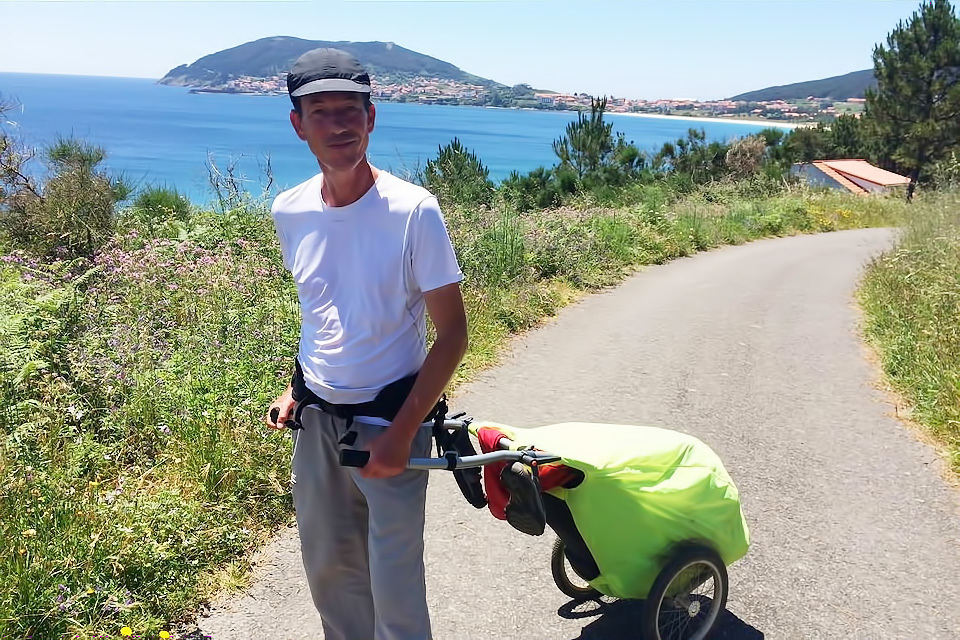
Beautiful hiking route along the coast at Fisterra
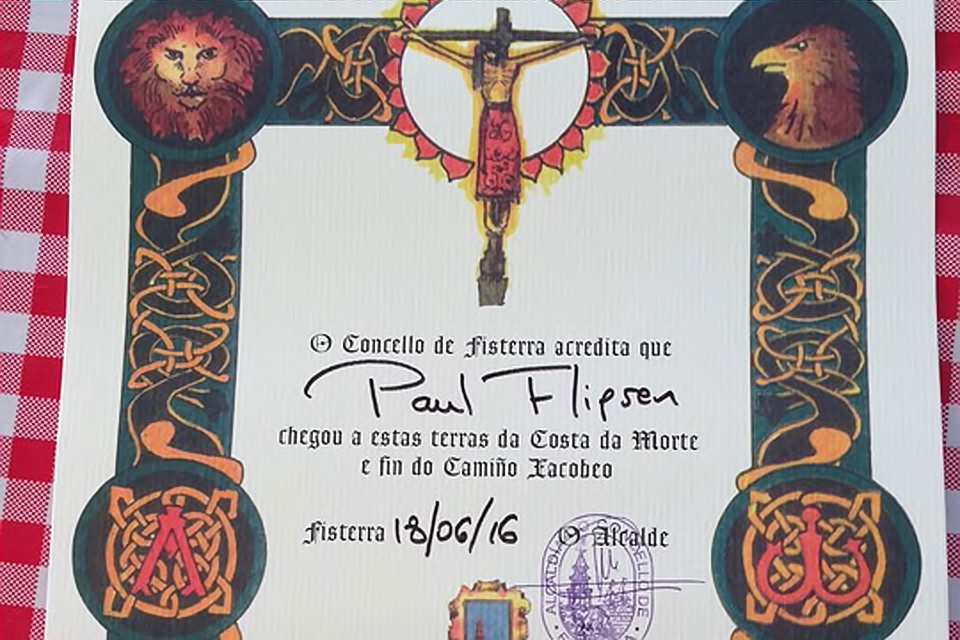
Official Fisterra certificate
3. Camino del Salvador (León-Oviedo)
León to Buiza: Doable. Some climbing and descending on country roads and occasional boulders.
From Buiza to Pajares: This is partly a very difficult route. Very steep climbing on rocky paths. The climb to Alto de los Romeros is particularly difficult. I did this in good weather conditions. With bad weather probably not doable. There is an alternative via the asphalt road, but these are many more kms!
Pajares to Pola de Lena: In the beginning a fairly steep descent, further on a horribly steep descent. Take the Wheelie in front of you and it can be done. Possible to descend by zigzagging. Pay attention to the weather, when it rains that last descent is a risk! Here too there is an alternative asphalt road (not even many more kms).
Pola de Lena to Oviedo: Largely asphalt and easy to do. Strong climbing and descending. In general, the del Salvador can be done with a Wheelie. You do need a strong condition. Certainly do not do this if you have not gained experience with your Wheelie.
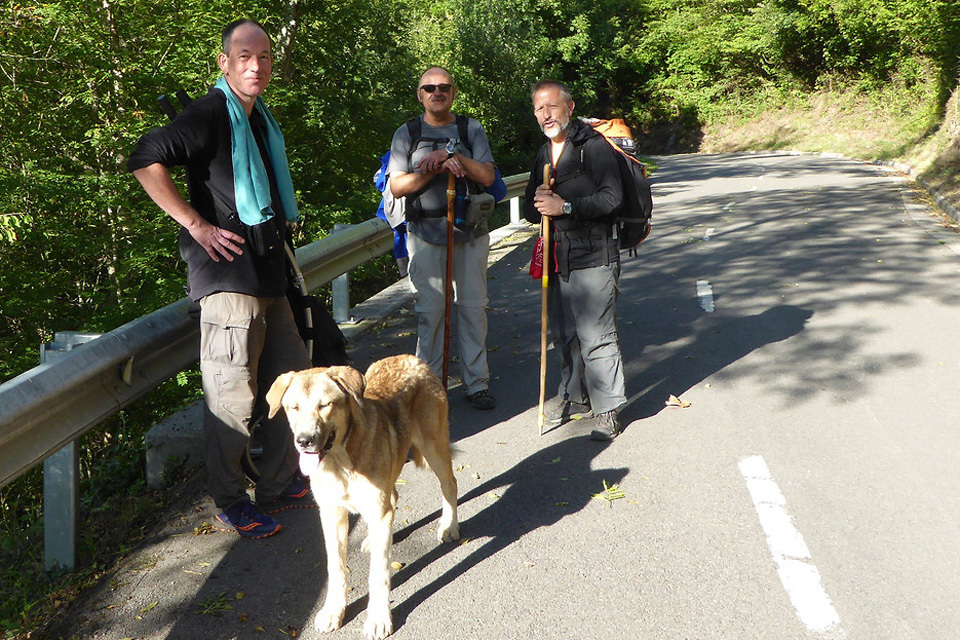
The Camino del Salvador is much quieter than the Camino Francés but not extinct
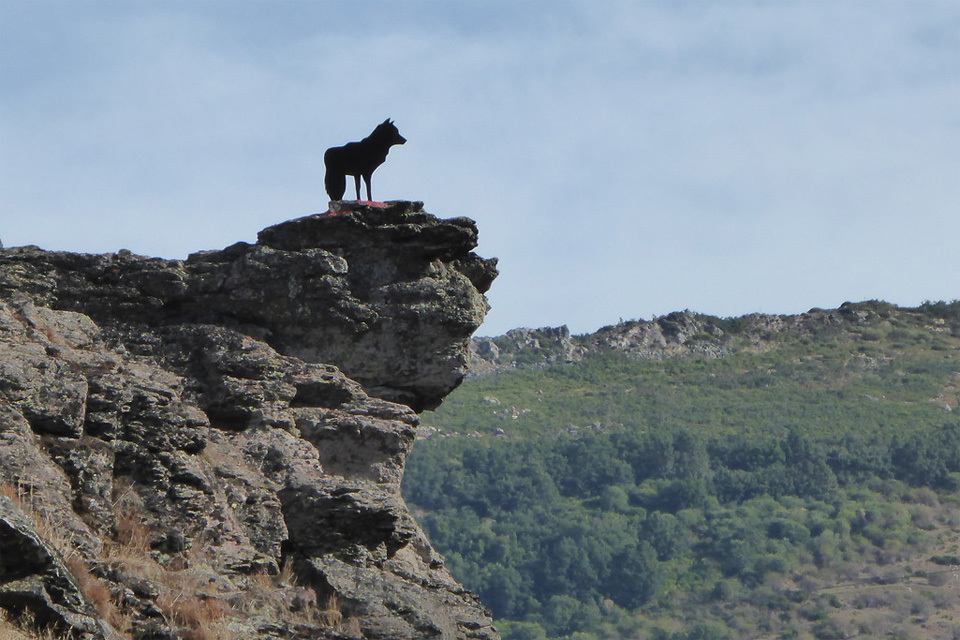
If you're lucky you'll spot a wolf...
4. Camino Primitivo (Oviedo-Santiago)
Oviedo to Borres: In addition to (steep) climbing / descending, cobblestone paths and possibly some mud no problem with the Wheelie. Note not easy, but doable.
Borres to Berducedo: Two options: There is the slightly simpler route via Pola de Allende with a Pilgrimage stay halfway through. I walked over the mountain via Hospital. This is an obligation of 25km. without any facilities on the route. Beautiful, but the climb is exhausting and difficult. Only do it in good weather and when you are sure of yourself. Heavy steep rocky and cobblestone paths and many altimeters.
Berducedo-Grandas de Salime: Also a tough stage, but now the other way around; descend firmly (more than 1000 meters!).
Grandas de Salime-A Fonsagrada: Another tough stage (together with points 2. and 3. the toughest route in the Primitivo). Lots of climbing and descending.
A Fonsagrada-Santiago: Relatively easy. In general, I think Primitivo can be done with a Wheelie, but you do need a good condition. Certainly not adviced if you have not gained experience with your Wheelie.
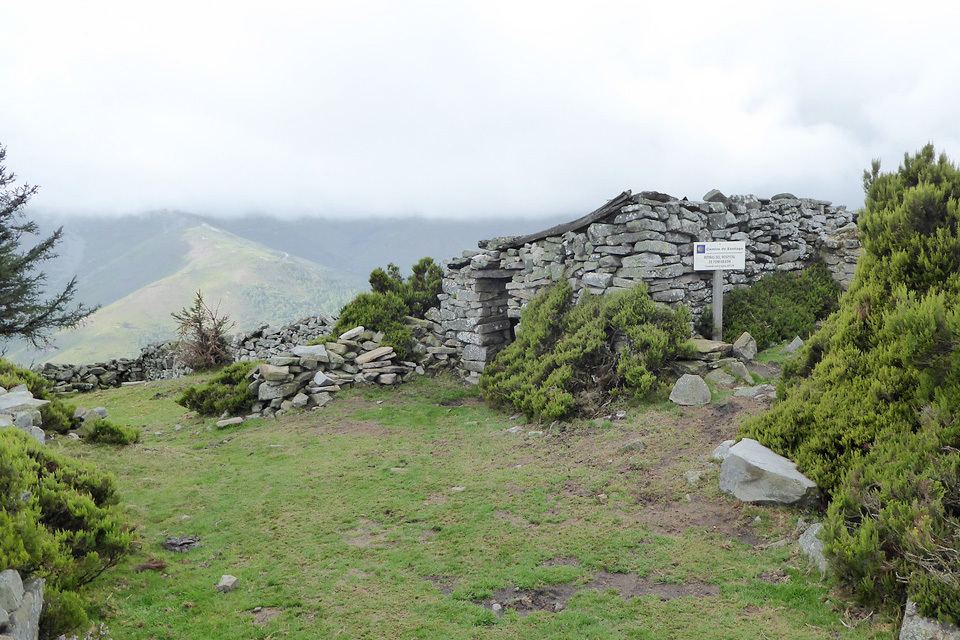
Old ruin of pilgrim stay at Hospital
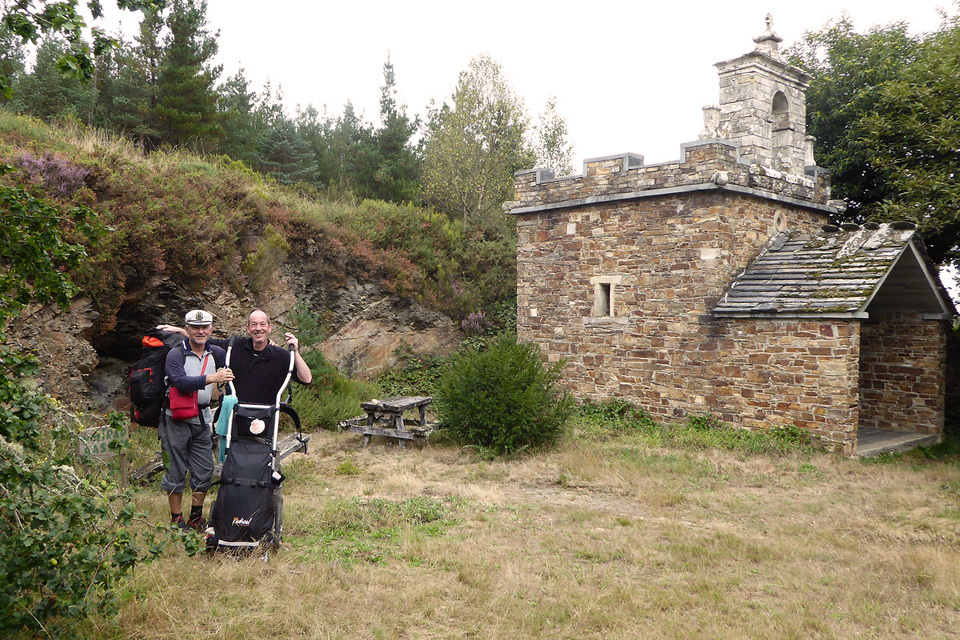
Meeting with a Russian pilgrim
5. Camino Inglés (Ferrol-Santiago)
See also the Inglés from A Coruna above: No significant problems, good to do.
6. Camino Lebaniego/Ruta Vadiniense (Santander-Mansilla de las Mulas)
As a fanatic Wheelie user, I look for a somewhat harder challenge every year. Walked this route in 2018 and it is really quite challenging. For most Wheelie users probably too heavy. In addition, this route is not walked much (1, 2 sometimes 5 people per day). So realize that you are probably on your own. In addition, the route (certainly Vadiniense) is often poorly marked and you definitely need a GPS-track on your mobile. In addition, in 2018 I had (unexpected) snow above 1400 meters, which made navigation difficult (the path is often not visible). However, if you are sure of yourself and want to experience the most beautiful Camino, then here are some of the difficulties I encountered. Apart from the snow at height, I hardly had any rain or other bad weather.
Also keep in mind that there are often no facilities between inn departure and inn arrival. (I had to borrow 20 euros from an English fellow pilgrim myself, because there is no ATM between San Vicente and Potes!). Also think of sufficient water and food.
Santander-Serdio: No problem. This is also a section of the Del Norte.
Serdio-Cicera: Beautiful route along Rio Nansa. Difficulty here are the many wooden gates and stairs. The Wheelie must be lifted over these obstacles several times. This takes some time, but the route is not very difficult. Take your time, beautiful route! Part of the path along the river is narrow and descending. Take the Wheelie here in front of you. A tricky part in the rain!
Cicera-Potes: In Cicera you can choose 2 routes. I chose the official one, because the marking of the alternative was crossed out. Shortly after Cicera, however, this official path becomes very difficult, steep and strewn with huge boulders. The rise is 300 meters in a short time. This is one of the toughest pieces I have done with my Wheelie! I do not know the alternative route, but I can imagine that it is easier. So study the route well at this point. After the ascent, a long descent follows, which is easy to do on a wide country road. The last kms to Potes on pavement along asphalt road. Near Potes is Monasterio Santa Toribio de Lebana. Here you can get a "compostela" for your trip from Santander. The inn near the monasterio is usually closed (only open in holy year, every 10 years). So spend the night in Potes. The climb to the monasterio is tough. Possibly in the morning, when you walk to Espinama. Please note: after the monasterio the route indication will get worse!
Potes-Espinama: Serious climb and descent, more than 1200 meters up and more than 800 meters down. Here you officially take various paths parallel to the asphalt road. Not extremely difficult, but you have the opportunity to take the asphalt road several times. A strenuous route due to the long climbing and descending.
Espinama-Portilla de la Reina: There is a short route of 21 km. and a longer one of 25km. My advice is to take the longer route, a bit easier, but still very serious! This is the queen stage over Picos de Europa, with a peak at ca. 1800+ meters. Only do it in good weather. Certainly not take on this route in foggy conditions. Heavy climbing, usually on reasonably accessible paths.
Obligation of 25 km without facilities on the way (also no water). Good to indicate at the inn that you are walking this route and call when you arrive safely. Also make sure you have a good GPS track on your mobile, the weather can change very quickly here. There is no simple alternative here over an asphalt road! About half of the route is climbing. After this you get a slightly descending asphalt road (hardly ridden) that is very easy to do with the Wheelie.
Portilla de la Reina-Mansilla de las Mullas: Easy end to the Vadiniense. Almost continuous light descent on mainly asphalt roads. At San Miguel de Escanda there is a choice to walk to Villavente (a little further on the Camino Francés). This will save you about 6 km on the Francés, but the path here is hilly and can be very muddy.
There is no "Compostela" for the Ruta Vadiniense. However, you will have one of the most beautiful Caminos behind you!
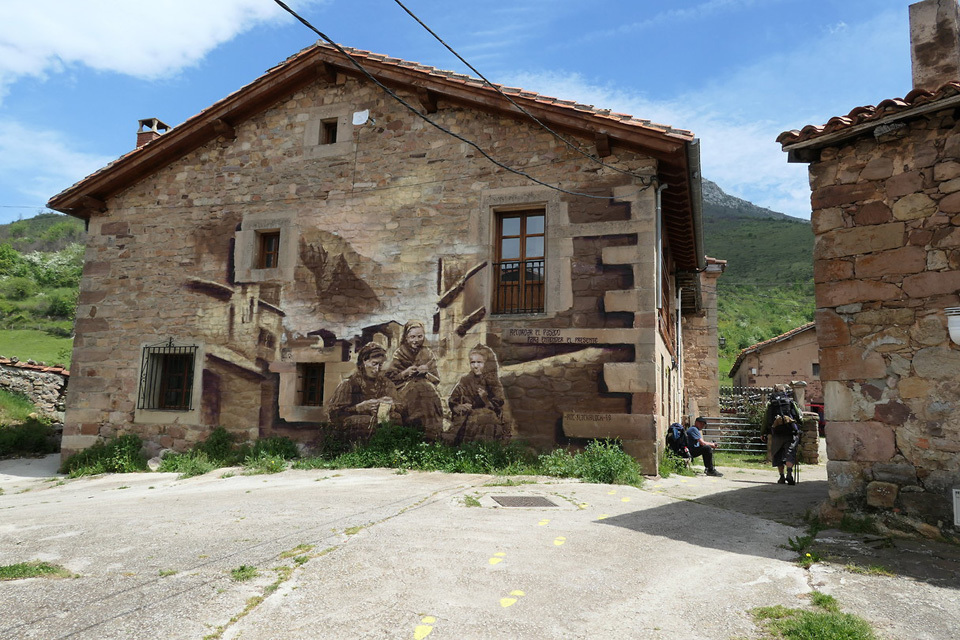
Pilgrim's stay in Cicera
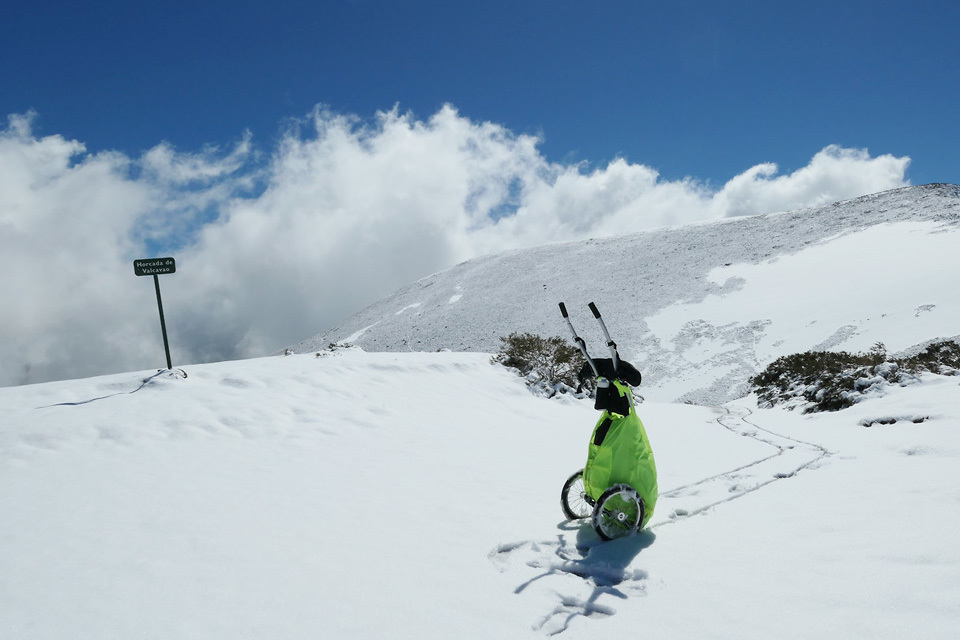
At 1800 meters with the Wheelie through the snow for Portilla
7. Camino Francés
I never walked the Camino Francés completely, only León up to Ponferrada and from Melide to Santiago. The pieces that I have walked are, in my opinion, very easy to do with a Wheelie. You also sometimes come across people with a Wheelie (or similar walking cart), who walked the entire Francés and who indicate that it can be done as a whole. I think that The Camino Francés in particular is the ideal route for the Wheelie.
8. Camino Invierno (Ponferrada to Santiago de Compostela)
At Ponferrada, the Camino Invierno splits off from the Camino Francés and is a (much!) quieter alternative. I walked this at the end of May 2018 and on the way I only saw 2 pilgrims walking the same route. At the end you see more people, because of the meeting with the Via de la Plata.
In itself, the level of this Camino is similar to the Francés. However, there is one big difference; the route is less crowded and is therefore not "flattened" everywhere. Sometimes a small path is hardly visible. You also come across narrow paths, high grass and a lot of mud in wet weather. I found myself (while it was relatively dry on my trip) several impassable mud trails. So bad that I decided to lift the Wheelie over the barbed wire to take on parts of the route through meadows. Just like on almost all Camino's, you can walk via an alternative route, over asphalt, which is of course less attractive.
I found the beauty of nature surprising on such a low-traffic route. It really is a very beautiful route. A disadvantage of all that silence and peace is shelter. There are more than enough accommodations, but prices range from around € 20 for a hostal / board to more than € 60 for hotels. I managed, with a little bit of planning, to keep the costs between € 20 and € 40. Positive is that almost all accommodations are tidy (a lot better than most hostels!). Another very striking thing about the Invierno is the friendliness and helpfulness of the population on route. I think this was my most friendly Camino.
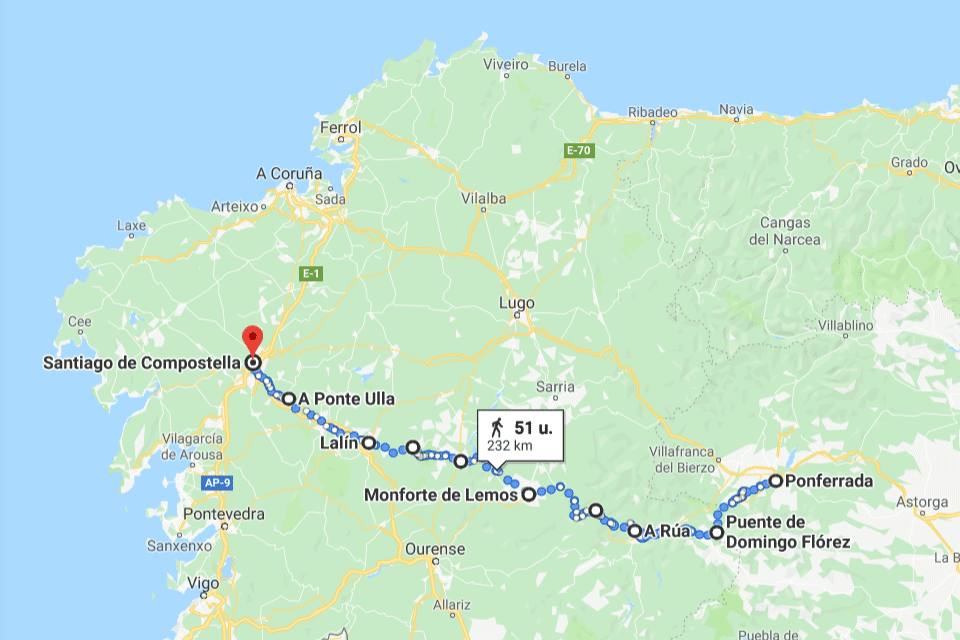
Camino Invierno - Ponferrada to Santiago
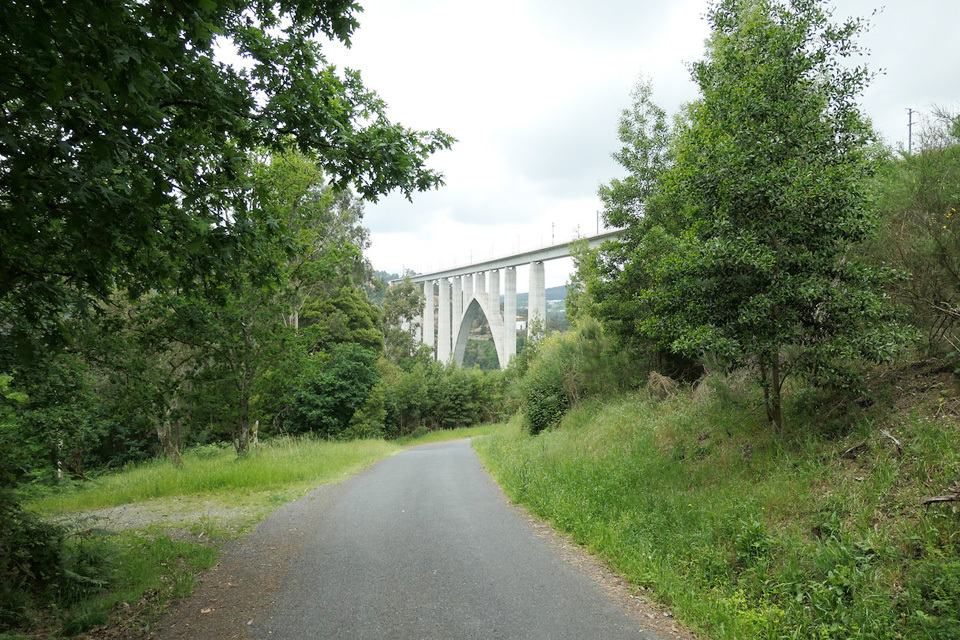
A Ponte Ulla - Magnificent architecture on the Camino Invierno
Final word
I hope that you as a Wheelie user can benefit from the above description of my experiences with the Walking Trailer. Of course my opinion is somewhat colored. I am clearly a rather fanatic Wheelie owner, seeing potential problems on route as just another challenge to take on. It is a kick for me to see afterwards which paths I have managed to beat. So please read on the internet also on the experiences of other users. Opinions will often be miles apart. En route I have spoken with many about the trailer and not everyone envision themselves using a Wheelie. Yet I also met interested people that I allowed to try out my Wheelie and got very enthusiastic. In short, it depends on many factors whether the Wheelie suits you. In addition to reading reviews, try renting or borrowing a Wheelie. Also, don't go too easy on your Wheelie, and take a varied and difficult trail.
My cart now has more than 4000km on the clock, has experienced all those Camino's and has only a few scratches on the frame and one broken spoke. It may look a bit simple, but it is amazingly strong. In terms of maintenance, occasionally check / tighten the bolts of the frame and keep the axles lightly greased.
Paul Flipsen, June 2018
The entire travel log with photos can be found at his Dutch site: https://paul2.reislogger.nl
Complete Routes in Towns
Route 1: Wittem (NL), Aubel (BE), Luik, Esneux, Huy, Namen, Dinant, Givet (FR), Fumay, Rocroi, Signy-l'Abbaye, Château-Porcien, Bazancourt, Reims, Épernay, Baye, Sézanne, Méry-sur-Seine, Rosières-près-Troyes, Ervy-le-Châtel, Chablis, Bessy-sur-Cure, Vézelay, Corbigny, Prémery, Urzy, Cuffy, Augy-sur-Aubois, Saint-Amand-Montrond, Le Châtelet, La Châtre, Cluis, Crozant, La Souterraine, Saint-Goussaud, Saint-Léonard-de-Noblat, Limoges, Flavignac, Saint-Pierre-de-Frugie, Thiviers, Sorges, Périgueux, Saint-Astier, Mussidan, Port-Sainte-Foy-et-Ponchapt, Pellegrue, La Réole, Brouqueyran, Captieux, Roquefort, Bostens, Mont-de-Marsan, Saint-Sever, Beyries, Orthez, Sauveterre-de-Béarn, Ostabat-Asme, Saint-Jean-Pied-de-Port, Bidarray, Espelette, Ascain, Irun (ES), San Sebastián, Zarautz, Deba, Markina-Xemein, Gernika-Lumo, Derio, Bilbao, Pobeña, El Pontarrón, Santoña, Güemes, Santa Cruz de Bezana, Caborredondo, San Vicente de la Barquera, Cantabria, Pendueles, Villahormes, La Isla, Valbucar, Gijón, Avilés, Muros de Nalón, Soto De Luina, Cadavedo, Navia, Tapia de Casariego, As Anzas, Mondoñedo, Vilalba, Friol, Sobrado, A Salceda, Santiago de Compostela.
Route 2: Santiago de Compostela, Negreira, Olveiroa, Fisterra, Muxia, A Coruña, Hospital, Sigüeiro, Santiago de Compostela.
Route 3: León, La Robla, Poladura de la Tercia, Campomanes, Mieres, Oviedo.
Route 4: Oviedo, San Juan de Villapañada, La Espina, Borres, Berducedo, Padraira, A Fonsagrada, Castroverde, Lugo, Friol, Sobrado, Santa Irene, Santiago de Compostela.
Route 5: Sartaña, Ferrol, Pontedeume, Betanzos, Hospital, Sigüeiro, Santiago de Compostela.
Route 6: Santander, Santillana del Mar, Comillas, Serdio, Cades, Cicera, Potes, Espinama, Portilla de la Reina, Riaño, Valdoré, Gradefes, Villarente.
Route 7: León, Ponferrada - Melide, Santiago.
Route 8: Ponferrada, Puente de Domingo Flórez, A Rúa, Quiroga, Monforte de Lemos, Chantada, Rodeiro, Lalín, A Ponte Ulla, Santiago de Compostela
